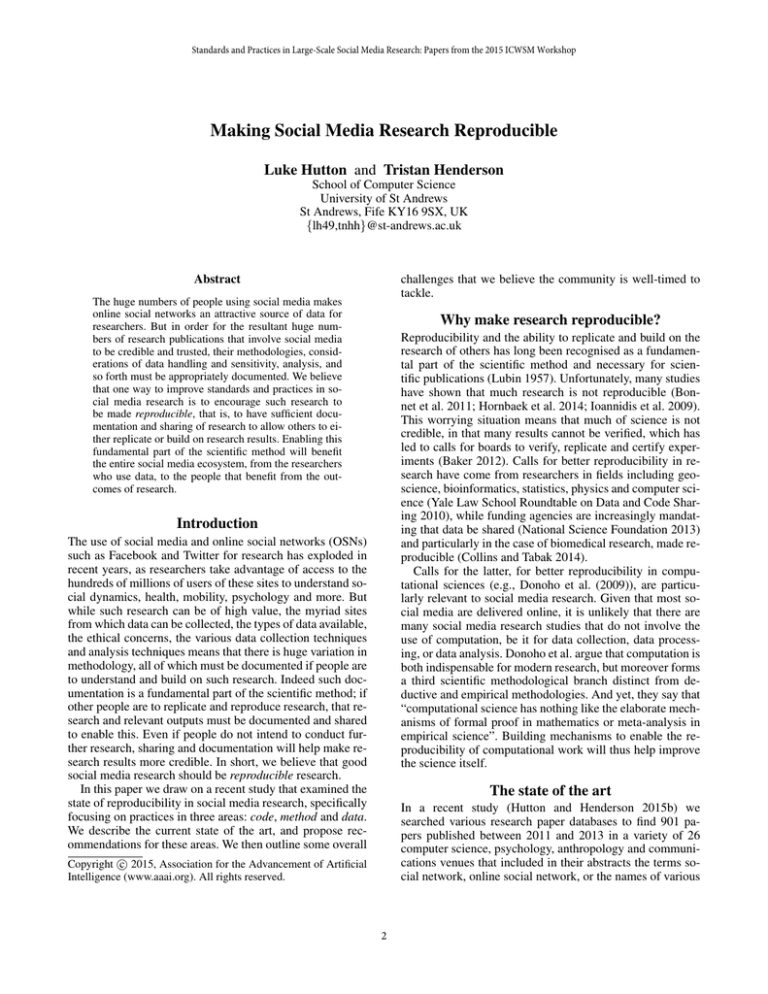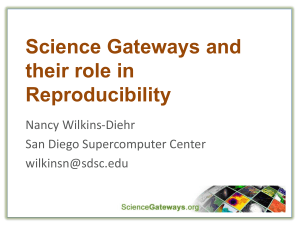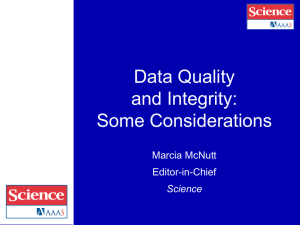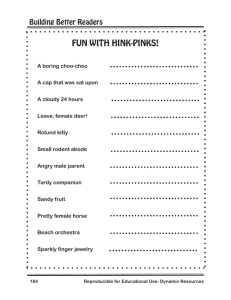
Standards and Practices in Large-Scale Social Media Research: Papers from the 2015 ICWSM Workshop
Making Social Media Research Reproducible
Luke Hutton and Tristan Henderson
School of Computer Science
University of St Andrews
St Andrews, Fife KY16 9SX, UK
{lh49,tnhh}@st-andrews.ac.uk
challenges that we believe the community is well-timed to
tackle.
Abstract
The huge numbers of people using social media makes
online social networks an attractive source of data for
researchers. But in order for the resultant huge numbers of research publications that involve social media
to be credible and trusted, their methodologies, considerations of data handling and sensitivity, analysis, and
so forth must be appropriately documented. We believe
that one way to improve standards and practices in social media research is to encourage such research to
be made reproducible, that is, to have sufficient documentation and sharing of research to allow others to either replicate or build on research results. Enabling this
fundamental part of the scientific method will benefit
the entire social media ecosystem, from the researchers
who use data, to the people that benefit from the outcomes of research.
Why make research reproducible?
Reproducibility and the ability to replicate and build on the
research of others has long been recognised as a fundamental part of the scientific method and necessary for scientific publications (Lubin 1957). Unfortunately, many studies
have shown that much research is not reproducible (Bonnet et al. 2011; Hornbaek et al. 2014; Ioannidis et al. 2009).
This worrying situation means that much of science is not
credible, in that many results cannot be verified, which has
led to calls for boards to verify, replicate and certify experiments (Baker 2012). Calls for better reproducibility in research have come from researchers in fields including geoscience, bioinformatics, statistics, physics and computer science (Yale Law School Roundtable on Data and Code Sharing 2010), while funding agencies are increasingly mandating that data be shared (National Science Foundation 2013)
and particularly in the case of biomedical research, made reproducible (Collins and Tabak 2014).
Calls for the latter, for better reproducibility in computational sciences (e.g., Donoho et al. (2009)), are particularly relevant to social media research. Given that most social media are delivered online, it is unlikely that there are
many social media research studies that do not involve the
use of computation, be it for data collection, data processing, or data analysis. Donoho et al. argue that computation is
both indispensable for modern research, but moreover forms
a third scientific methodological branch distinct from deductive and empirical methodologies. And yet, they say that
“computational science has nothing like the elaborate mechanisms of formal proof in mathematics or meta-analysis in
empirical science”. Building mechanisms to enable the reproducibility of computational work will thus help improve
the science itself.
Introduction
The use of social media and online social networks (OSNs)
such as Facebook and Twitter for research has exploded in
recent years, as researchers take advantage of access to the
hundreds of millions of users of these sites to understand social dynamics, health, mobility, psychology and more. But
while such research can be of high value, the myriad sites
from which data can be collected, the types of data available,
the ethical concerns, the various data collection techniques
and analysis techniques means that there is huge variation in
methodology, all of which must be documented if people are
to understand and build on such research. Indeed such documentation is a fundamental part of the scientific method; if
other people are to replicate and reproduce research, that research and relevant outputs must be documented and shared
to enable this. Even if people do not intend to conduct further research, sharing and documentation will help make research results more credible. In short, we believe that good
social media research should be reproducible research.
In this paper we draw on a recent study that examined the
state of reproducibility in social media research, specifically
focusing on practices in three areas: code, method and data.
We describe the current state of the art, and propose recommendations for these areas. We then outline some overall
The state of the art
In a recent study (Hutton and Henderson 2015b) we
searched various research paper databases to find 901 papers published between 2011 and 2013 in a variety of 26
computer science, psychology, anthropology and communications venues that included in their abstracts the terms social network, online social network, or the names of various
c 2015, Association for the Advancement of Artificial
Copyright Intelligence (www.aaai.org). All rights reserved.
2
popular OSNs. From the original 901, we found that 505 papers actually used data from OSNs.1 We then examined each
of these papers to determine how “reproducible” they were.
Following Thompson and Burnett (2012), we characterise
reproducibility by three elements:
50%
40%
Criteria satisfaction
• does a research artefact share the source code, tools, and
workflows required to replicate the data collection that led
to the creation of the artefact?
• does an artefact encode the scripts and methods that conduct analyses and produce the components of an artefact?
• does an artefact include the dissemination of raw data and
other resources required for replication?
We can broadly describe these as the documentation and
dissemination of code, methods and data respectively. Each
of the 505 papers that we examined were tested against ten
criteria which addressed these categories:
30%
20%
10%
1. Code: Were source code or software tools shared?
0%
2. Method: Was the source OSN used described?
code
data
method
Criteria type
3. Method: Was the measurement or sampling strategy used
to collect data described?
Figure 1: Barplot showing how well our three criteria types
are met by the papers we study, with standard error between
disciplines shown. Data-sharing is particularly poor across
most disciplines, while reporting of methodologies is generally stronger. The sharing of code is the most variable practice between disciplines.
4. Method: Was the length of the study described?
5. Method: Were the number of participants or data points
described?
6. Method: Were mechanisms for processing data, sanitising, aggregating, anonymising and so forth described?
7. Method: Was consent obtained from participants in the
OSN, and if so was this described and how?
Approximately a quarter of workshop and journal papers
share their code, while 41.4% of conference papers do so.
We can attribute this to researchers perhaps being reticent
to share unfinished code with a workshop audience, while
more computer science conferences are requiring authors to
provide supplementary materials, such as source code, with
their papers.
There exist many new initiatives for capturing and archiving code for research experiments, for instance recomputation.org (Gent 2013), the Software Sustainability Institute (Crouch et al. 2013), or RunMyCode (Hurlin, Pérignon,
and Stodden 2014), which can all help with the sharing of
code, tools, or even virtual machines that encapsulate all of
the code and data needed to run the analysis to create plots,
or an entire research paper. Researchers can also use source
code hosting services such as GitHub,2 but such services do
not provide specific support for maintaining research code.
8. Method: Were participants briefed or debriefed to explain
the research, and was this described?
9. Method: Were there any ethical concerns and how were
these addressed? Was IRB (Institutional Review Board)
or ethics committee approval needed and obtained?
10. Data: Were datasets used for the research either cited
(where other data were used), or provided (where original data were collected)?
Unfortunately, like the aforementioned surveys in other
disciplines, we found that many of these papers were not
reproducible. Indeed, we only found one paper that met all
ten criteria. Figure 1 highlights how well all criteria were
reported across the survey.
Reproducible code?
Code and protocols were not particularly well documented.
Computer science papers were better at this, but social science papers rarely share code and protocols. None of the
psychology papers and only 5.6% of communications papers we examined shared code. This may be due to conventions in these fields, and so one open challenge is to open
up dialogue or sharing of best practices across communities.
Reproducible method?
Of the three areas that we examined, the sharing of methodologies was by far the strongest. Basic parameters such as
the source OSN, sampling strategies, length of studies and
the number of participants were almost (but not always) universally reported. But other parameters to do with the handling of data and participants, and in particular the reporting of ethical concerns, were generally not discussed. The
1
Full details are available in the paper and the dataset of papers
studied, which can be found in the FigShare data archive (Henderson and Hutton 2014).
2
3
GitHub: http://www.github.com
venues that were best at reporting these were security and
privacy venues; this might be due to the fact that venues
such as SOUPS (Symposium on Usable Privacy and Security) requires the describing of ethical concerns and how
these were tackled, while WPES (Workshop on Privacy in
the Electronic Society) allows appendices with supplementary information to be included. We note that ICWSM and
other venues, such as ACM SIGCOMM, have started asking submitters whether ethics approval was obtained. But to
aid the reproducibility of work, and to allow readers to truly
understand how a study was conducted, it would be good to
consider adopting best practices from SOUPS and WPES,
and allowing additional appendices. Another possible route
for improving standards might be to look at some of the proposed guidelines for social media research (McKee 2013;
Rivers and Lewis 2014), although some of these are quite
specific to subsets of such research and may not be appropriate to social media research at large.
be to build mechanisms for capturing experimental workflows and exporting these for distribution and replication are
needed. The need for easy automated capture of experimental context and workflow has already been noted as a key
driver for improving reproducibility (Davison 2012), and
the e-science community in particular has developed various workflow tools (De Roure et al. 2010).
Capturing the workflow of social media experiments has
particular challenges, and goes beyond sharing the source
code of tools used to collect and analyse data. We suggest
that to support reproducibility, the following aspects of the
workflow (code and method) must be captured:
1. Data sampling strategy First, we must consider about
whom the data we collect relates. Is it possible to encode
details about the population sampled? This might mean
users who tweeted using a certain hashtag, or a stratified
distribution of participants meeting certain demographic
criteria. Motivated by our survey, in which these details
were reported in 71.9% of cases, it is important to be able
to encode these details such that others can replicate the
procedures and compare their findings. This introduces
particular issues where the content collected is unique to
a point in time, such as Denef et al.’s study of tweeting
practices during the 2011 London riots (Denef, Bayerl,
and Kaptein 2013). Even if we can encode these sampling
details, it may not be possible to collect a similar distribution of content in a replication, as the APIs provided by
social media services do not usually provide archival access, and streaming APIs provide a limited subset of all
published content (Morstatter et al. 2013).
Reproducible data?
Only 6.1% of the papers in our survey shared or cited data.
This was somewhat surprising given moves by journals and
funding bodies to encourage or even mandate the sharing of
research data. Data sharing is one area where ICWSM does
relatively well, with the existing ICWSM data sharing initiative3 meaning that 35.4% of the (admittedly small) number
of papers that shared data came from ICWSM. But overall
the picture is poor, and calls to improve this have already
been made (Huberman 2012).
Data sharing and data reuse in itself may not be sufficient
for reproducibility. In separate work one of the authors runs
the CRAWDAD wireless network data archive, which provides over 120 wireless datasets to 10,000 researchers, who
have used data for research papers, education, standards development and more (Kotz and Henderson 2005). The sharing of these datasets has clearly been beneficial to all of these
researchers, but merely offering datasets for download does
not guarantee that readers will be able to find the datasets
used in a paper. We need to enable mechanisms for appropriate data citation (Henderson and Kotz 2015) to allow readers
of papers to understand what data have been used, allow persistent identifiers for citation, and to provide credit and attribution to authors. The Force 11 Data Citation Principles4
go some way towards codifying these, and could perhaps be
considered by the community for social media datasets.
General education about how best to work with and use
data might also be useful for improving standards; groups
like Data Carpentry5 have experience in this space.
2. Ethical procedures We argue that the ethical procedures
of an experiment should be encoded to support replications, which as we noted earlier, does not often happen. Were the people whose data were collected considered human subjects, and as such were they informed
about the procedures of the experiment, and did they provide consent to participate? For all experiments, the steps
taken to preserve the privacy of participants should be
encoded, such as which personally identifiable information was removed, and whether sensitive data such as locations were obfuscated. All ethical procedures, including briefing documentation, consent forms, and sanitisation processes, are an important part of the workflow as
they have implications for the analysis of a study. For example, when replicating previous analyses, understanding
how data have been sanitised is necessary to put any findings in context, and avoid making assumptions the sanitised data do not support. As participants in social media
experiments are willing to share different types of data depending on the purpose of the research (McNeilly, Hutton,
and Henderson 2013), documenting the consent and briefing materials given to participants is necessary to conduct
replications in the same context, and to better understand
how the results were produced.
Reproducing workflows
From looking at the state of the art it is clear that improvements could be made to further the reproducibility of social media research, through sharing and documentation of
code, method and data. One overall way to do this might
3. Data collection Encoding the workflow of the data collection itself is essential. To an extent, this is encoded in
the source code for tools used to conduct experiments,
but replicating this binds other researchers to the same
3
http://icwsm.org/2015/datasets/datasets
4
https://www.force11.org/datacitation
5
http://datacarpentry.org/
4
the future, without the need for a third party service to be
available.
So far, we have used this system for our own social media
experiments, investigating location-sharing services (Hutton, Henderson, and Kapadia 2014), and informed consent
in Facebook studies (Hutton and Henderson 2015a), and to
replicate previous experiments from the social media privacy literature (Hutton and Henderson 2015b). Our tools do
not yet tackle all of the challenges we have identified, and as
it is not necessarily the case that these experiments are representative of all OSN research, we would welcome other
researchers to use our system. We are also keen to discuss
whether our model of the social media experiment workflow
is appropriate to all such experiments, and what extensions
we could develop to benefit researchers in the community.
We would like to contribute to the development of best practices for research in this area, building on the challenges we
have identified.
platforms and environments of the original research, and
may demand expertise in these environments to enable
replications. We argue that the data collection procedures
of an experiment should be encoded in a form which is
portable, human-readable, but can also be parsed by software to support the conduct of a study. Enumerating the
services data are collected from, the types of data collected and how they are sanitised, provides a specification
of the requirements of a study. In replications, this can
support applications for ethical approval by easily communicating the requirements of a study, and makes it easier for others to conduct a study under the same conditions.
4. Analysis Finally, we should capture how research outputs
are produced as a result of the data collection process.
Understanding what pre-processing was performed on a
dataset collected from social media and which analyses
were conducted is important to validate the findings of
others, and to directly compare results between studies.
As discussed earlier, this is a challenge for all computational research, and is not unique to social media studies.
Further challenges
Beyond documenting and sharing code, method and data,
some additional overall challenges must also be addressed.
One huge challenge with introducing new systems for data
capture, or mechanisms for sharing data, is sustaining these
systems. Running services that allow researchers to run or
replicate experiments would require community support and
funding beyond the scale of the current ICWSM data sharing
service.
Another particular problem with capturing social media
experiments, versus experiments in some other branches of
computational science, is the interactions with both people
and other systems that may be outside of a researcher’s control, e.g., the OSNs. For instance, when we attempted to
replicate the one reproducible paper from our survey, we
ran into trouble because the Facebook APIs had changed
since the original researchers’ experiment, and we were unable to retrieve the same information. Deciding how to deal
with such changes is difficult, but better documentation is a
good start. Some fifteen years ago, Floyd and Paxson (2001)
recognised the difficulties with simulating the Internet. Perhaps we now need to turn our efforts to recognising and addressing the challenges of capturing the relevant parts of the
Internet that constitute a research artefact and making such
artefacts reproducible.
Perhaps the biggest challenge is that of creating appropriate incentives for researchers to make their research more
reproducible. After all, any of the suggestions proposed here
involve additional effort on the part of busy and overworked
researchers. Our experiences with data sharing indicate that
“sticks” such as government or funding body mandates do
not necessarily seem to work, as we have not seen a significant increase in dataset contributions despite mandates
from the NSF in the USA, or the Research Councils in the
UK. Perhaps we should instead investigate “carrots”. There
is evidence that data sharing, for instance, will increase the
impact of research (Piwowar, Day, and Fridsma 2007). We
have also had some success with changing culture through
publication habits. For instance the ACM Internet Measurement Conference requires that data be shared, not for all pa-
Considering these four workflow steps, we are developing tools for social media experiments (Hutton and Henderson 2013) to support the encoding and sharing of social media experiment workflows. Researchers can specify a policy that governs data collection, sanitisation, processing and
captures ethical concerns and can generate consent forms
for participants. These policies can then be shared to allow
other researchers to replicate experiments. We are working
towards supporting all four requirements we outlined.
Our tools’ policy language allows the full data collection
procedures to be encoded, including how data are sanitised,
allowing other researchers to see at what stage in an experiment data are collected, and how they are sanitised and
stored. For example, in an experiment where location data
were collected, our policy can show whether the data were
collected at full resolution for analysis, then coarsened to reduce the chance of the participant being reidentified from a
resulting dataset. As our policy language enumerates all data
collection procedures, we can generate consent forms which
allow participants to understand exactly how their data are
used, rather than relying on boilerplate forms alone. These
policies are human-readable so that other researchers can
understand the procedures of an experiment, even if they do
not use our tools. If they do, however, our framework can
enforce the policy to ensure an experiment doesn’t collect
data beyond its remit. We have therefore made significant
progress towards the second and third steps we identified,
but open problems remain.
Sharing workflows will allow researchers to reproduce
code and method, but data must also be shared. Thus we
are interested in how we can extend support into the rest
of the workflow, allowing sampling strategies to be encoded
and shared, and whether we can support the sharing of other
research artefacts. One such approach might be to embed
an instance of our tools when sharing other items such as
source code and raw data, allowing policies to be re-used,
and provide programmatic access to social media datasets in
5
Floyd, S., and Paxson, V. 2001. Difficulties in simulating the
Internet. IEEE/ACM Transactions on Networking 9(4):392–
403.
Gent, I. P. 2013. The recomputation manifesto. Available
online at http://arxiv.org/abs/1304.3674.
Henderson, T., and Hutton, L. 2014. Data for the paper “Towards reproducibility in online social network research”. Available online at http://doi.org/10.6084/m9.
figshare.1153740.
Henderson, T., and Kotz, D. 2015. Data citation practices
in the CRAWDAD wireless network data archive. D-Lib
Magazine 21(1/2).
Hornbaek, K.; Sander, S. S.; Avila, J. A. B.; and Simonsen,
J. G. 2014. Is once enough?: On the extent and content of
replications in human-computer interaction. In Proceedings
of the SIGCHI Conference on Human Factors in Computing
Systems, 3523–3532.
Huberman, B. A. 2012. Sociology of science: Big data deserve a bigger audience. Nature 482(7385):308.
Hurlin, C.; Pérignon, C.; and Stodden, V. 2014. RunMyCode.org: A research-reproducibility tool for computational sciences. In Stodden, V.; Leisch, F.; and Peng, R. D.,
eds., Implementing Reproducible Research. Chapman and
Hall/CRC.
Hutton, L., and Henderson, T. 2013. An architecture for ethical and privacy-sensitive social network experiments. ACM
SIGMETRICS Performance Evaluation Review 40(4):90–
95.
Hutton, L., and Henderson, T. 2015a. “I didn’t sign up
for this!”: Informed consent in social network research. In
Proceedings of the 9th International AAAI Conference on
Web and Social Media (ICWSM).
Hutton, L., and Henderson, T. 2015b. Towards reproducibility in online social network research. IEEE Transactions on
Emerging Topics in Computing. To appear.
Hutton, L.; Henderson, T.; and Kapadia, A. 2014. “Here
I am, now pay me!”: Privacy concerns in incentivised
location-sharing systems. In Proceedings of the 2014 ACM
Conference on Security and Privacy in Wireless & Mobile
Networks, 81–86.
Ioannidis, J. P. A.; Allison, D. B.; Ball, C. A.; Coulibaly, I.;
Cui, X.; Culhane, A. C.; Falchi, M.; Furlanello, C.; Game,
L.; Jurman, G.; Mangion, J.; Mehta, T.; Nitzberg, M.; Page,
G. P.; Petretto, E.; and van Noort, V. 2009. Repeatability
of published microarray gene expression analyses. Nature
Genetics 41(2):149–155.
Kotz, D., and Henderson, T. 2005. CRAWDAD: A Community Resource for Archiving Wireless Data at Dartmouth.
IEEE Pervasive Computing 4(4):12–14.
Lubin, A. 1957. Replicability as a publication criterion.
American Psychologist 12(8):519–520.
McKee, R. 2013. Ethical issues in using social media for
health and health care research. Health Policy.
McNeilly, S.; Hutton, L.; and Henderson, T. 2013. Understanding ethical concerns in social media privacy studies.
pers, but if a paper is to be considered for the Best Paper
Award. Such steps can encourage researchers to make their
work more reproducible without being overly punitive.
But perhaps the best incentive is to return to Donoho
et al. (2009), who say that “striving for reproducibility imposes a discipline that leads to better work.”
Conclusions
We have posited that one way to develop better standards
and practices in social media research is to encourage such
research to be reproducible. By documenting and sharing research in such a way that others can replicate or build on
results, the original researchers will hopefully improve their
practices, while other researchers will benefit by improved
access to research outputs, but also by the sharing and dissemination of research practices themselves. We have offered a brief look at the state of the art in reproducibility,
outlined our work-in-progress workflow tool, and touched
on some (but not all) of the outstanding challenges that need
to be addressed.
References
Baker, M. 2012. Independent labs to verify high-profile
papers. Nature. Available online at http://doi.org/10.1038/
nature.2012.11176.
Bonnet, P.; Manegold, S.; Bjørling, M.; Cao, W.; Gonzalez,
J.; Granados, J.; Hall, N.; Idreos, S.; Ivanova, M.; Johnson,
R.; Koop, D.; Kraska, T.; Müller, R.; Olteanu, D.; Papotti, P.;
Reilly, C.; Tsirogiannis, D.; Yu, C.; Freire, J.; and Shasha, D.
2011. Repeatability and workability evaluation of SIGMOD
2011. ACM SIGMOD Record 40(2):45–48.
Collins, F. S., and Tabak, L. A. 2014. Policy: NIH plans to
enhance reproducibility. Nature 505(7485):612–613.
Crouch, S.; Hong, N. C.; Hettrick, S.; Jackson, M.; Pawlik,
A.; Sufi, S.; Carr, L.; De Roure, D.; Goble, C.; and Parsons,
M. 2013. The Software Sustainability Institute: Changing
research software attitudes and practices. Computing in Science & Engineering 15(6):74–80.
Davison, A. 2012. Automated capture of experiment context
for easier reproducibility in computational research. Computing in Science & Engineering 14(4):48–56.
De Roure, D.; Goble, C.; Aleksejevs, S.; Bechhofer, S.; Bhagat, J.; Cruickshank, D.; Fisher, P.; Kollara, N.; Michaelides,
D.; Missier, P.; Newman, D.; Ramsden, M.; Roos, M.; Wolstencroft, K.; Zaluska, E.; and Zhao, J. 2010. The evolution
of myExperiment. In Proceedings of the IEEE 6th International Conference on E Science (e-Science), 153–160.
Denef, S.; Bayerl, P. S.; and Kaptein, N. A. 2013. Social
Media and the Police: Tweeting Practices of British Police
Forces During the August 2011 Riots. In Proceedings of
the SIGCHI Conference on Human Factors in Computing
Systems, CHI ’13, 3471–3480. New York, NY, USA: ACM.
Donoho, D. L.; Maleki, A.; Rahman, I. U.; Shahram, M.; and
Stodden, V. 2009. Reproducible research in computational
harmonic analysis. Computing in Science & Engineering
11(1):8–18.
6
In Proceedings of the ACM CSCW Workshop on Measuring
Networked Social Privacy: Qualitative & Quantitative Approaches.
Morstatter, F.; Pfeffer, J.; Liu, H.; and Carley, K. M. 2013. Is
the Sample Good Enough? Comparing Data from Twitter’s
Streaming API with Twitter’s Firehose. In Proceedings of
the 7th International AAAI Conference on Web and Social
Media (ICWSM).
National Science Foundation.
2013.
Other Post
Award Requirements and Considerations.
Available
online at http://www.nsf.gov/pubs/policydocs/pappguide/
nsf13001/aag 6.jsp#VID4.
Piwowar, H. A.; Day, R. S.; and Fridsma, D. B. 2007. Sharing detailed research data is associated with increased citation rate. PloS one 2(3):e308+.
Rivers, C. M., and Lewis, B. L. 2014. Ethical research standards in a world of big data. F1000Research.
Thompson, P. A., and Burnett, A. 2012. Reproducible research. CORE Issues in Professional and Research Ethics
1(6).
Yale Law School Roundtable on Data and Code Sharing.
2010. Reproducible research. Computing in Science & Engineering 12(5):8–13.
7






